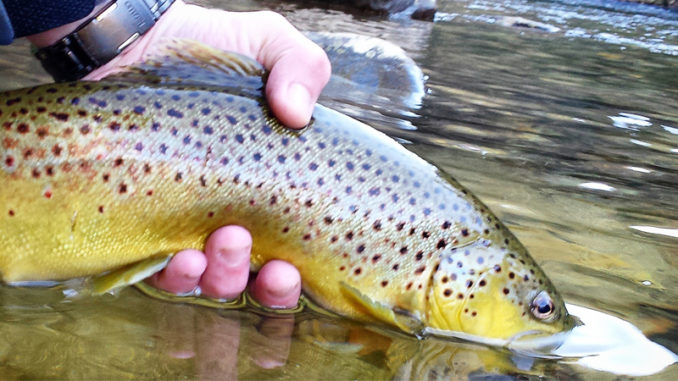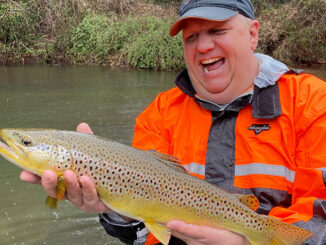
Spawning trout are an autumn adventure
In late September, autumn eases into the mountains with the first dull-red coloring of sourwood, dogwood and sumac leaves. Joe Pye weed, ironweed, asters, goldenrod and oxeye daisies brighten fields, pastures and roadsides in a dazzling array of colors. It’s a beautiful mixture of deep purple, lavender, pale blue and bright yellow. Tart fox grapes and fragrant muscadines hang in heavy clusters from ropey vines. Ripe hickory nuts, buckeyes and acorns spatter the forest floor. Mountain peaks and ranges, once obscured by summer haze, stand out clear and distinct as far as the eye can see.
This is the time of sweater mornings, shirt-sleeve afternoons and blanket evenings. It’s a bountiful time for both humans and animals. This time of year, brown trout and brook trout begin their annual spawning rituals. They begin as early as mid-September and can continue into November, depending on weather and stream conditions.
Of the two species, the brown trout is the most visible and most active. The male brown trout’s colors, especially the distinctive red spots on its sides, become more vivid. And males develop a pronounced hook or kype in the lower jaw.
At the beginning of the cycle, adult browns leave their usual hiding places in deep pools and begin moving upstream. They are searching for likely places to spawn. During this time, browns feed heavily, building up strength and stamina for the mating ritual. This is prime fishing time for brown trout. And the movement can continue for a couple of months since all brown trout do not spawn at the same time. They’re easy to find, easy to see and much easier to catch.
Numerous flies are deadly this time of year
Large flies such as No. 12 or No. 10 chartreuse, olive or black Woolly Boogers are especially effective for prespawn browns. Kevin Howell of Davidson River Outfitters in Brevard, N.C., said browns will hit Woolly Boogers because they think they’re salamanders. Other deadly flies are a No. 10 Bitch Creek Nymph and No. 12 or No. 10 Girdle Bugs. Spinning lures such as a 1/4-ounce Mepps Aglia or a Panther Martin with a black body and yellow dots also work well on prespawn trout.
Females seek out the spawning sites. Males merely follow to accommodate them. Once a female brown finds a suitable spawning site, she uses her tail to dig out a small depression, or redd, in a clean area free of silt and sand and with numerous pebbles. Female browns prefer the tail-end of a run or riffle where water is shallow and water flow is adequate enough to keep the redd oxygenated.
While the female does the work, the male waits patiently until the redd is prepared and the female is ready to deposit her eggs. When the female indicates she’s ready, the male joins her, and, side by side, backs arched, jaws open, they complete the ritual with the female depositing her eggs over the redd and the male emitting a cloud of semen to fertilize the eggs. Using her tail again, the female covers the eggs with pebbles and small rocks. She buries them anywhere from a couple of inches deep to 6 inches deep.
Catch and release has minimal effect on trout spawn
During the actual spawning, neither the male nor the female feeds. The male, however, will strike at anything he thinks is a threat to the female or her eggs. Once the eggs are laid and covered, the brown’s parental duties are over. The eggs and subsequent fry are on their own. Eggs can survive even if temperatures drop to below zero, as long as the water doesn’t freeze, a rarity for high-gradient, southern Appalachian streams. Once eggs are laid and covered, they remain in the redd until spring. Hatching usually occurs between mid-January and mid-March. When the fry are able to forage on their own, they leave the redd.
When spawning is complete, browns return to their former habitat. For post-spawn brown trout, egg patterns such as Glow Bugs are very effective because brown trout often eat the eggs and young of other trout.
Brook trout follow much the same spawning patterns as brown trout, only the spawning comes later. Prime spawning time for brook trout is mid-October through mid-November. Since wild brook trout usually are found in small streams, they don’t move as much or as far as browns.
Don’t overlook tributaries when searching for these fish
As for catching either brook or brown trout during the spawning cycle, fisheries biologists say angling activity does not adversely affect a spawn if a trout is not injured or played to exhaustion when it’s caught. When released, the trout will resume its spawning activities. The key word is “release.” Kill a spawning trout, and you’ve destroyed an entire generation of trout.
Best places to find larger brown trout during the spawning cycle are in the tributaries of large streams such as the Tuckasegee River, Nantahala River, East Fork of the Pigeon River, South Toe River and Davidson River.
Tributaries that feed lakes also are prime spawning grounds for lake trout. Big browns from Lake Jocassee move up the Thompson River, Whitewater River and Horsepasture River to spawn. Big browns from Davidson go to Cove Creek and Avery Creek.
Good weather and good fishing. Fall in the mountains is indeed a magical time.
Click here to read more about trout fishing in the Carolinas.





Be the first to comment